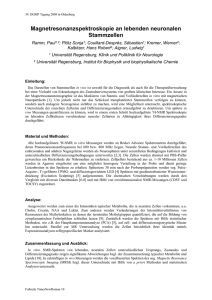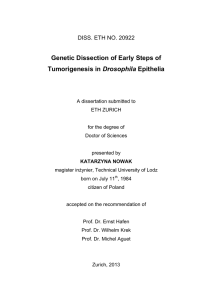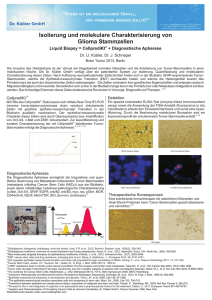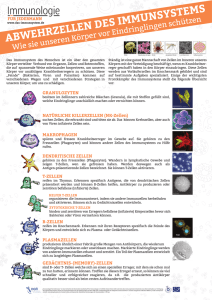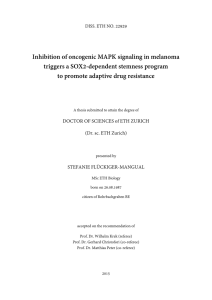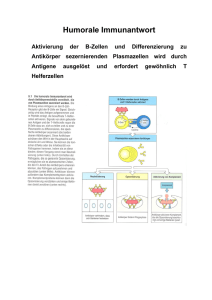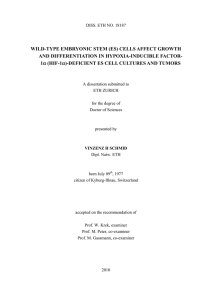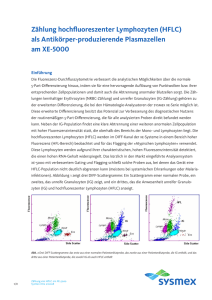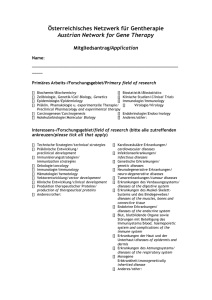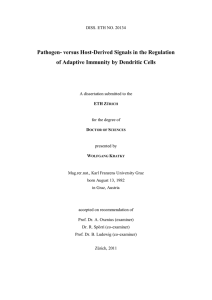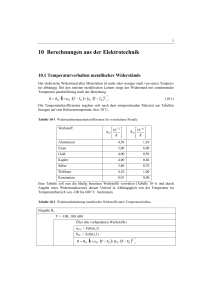Diss. ETH No. 18334 IDENTIFICATION AND - ETH E
Werbung
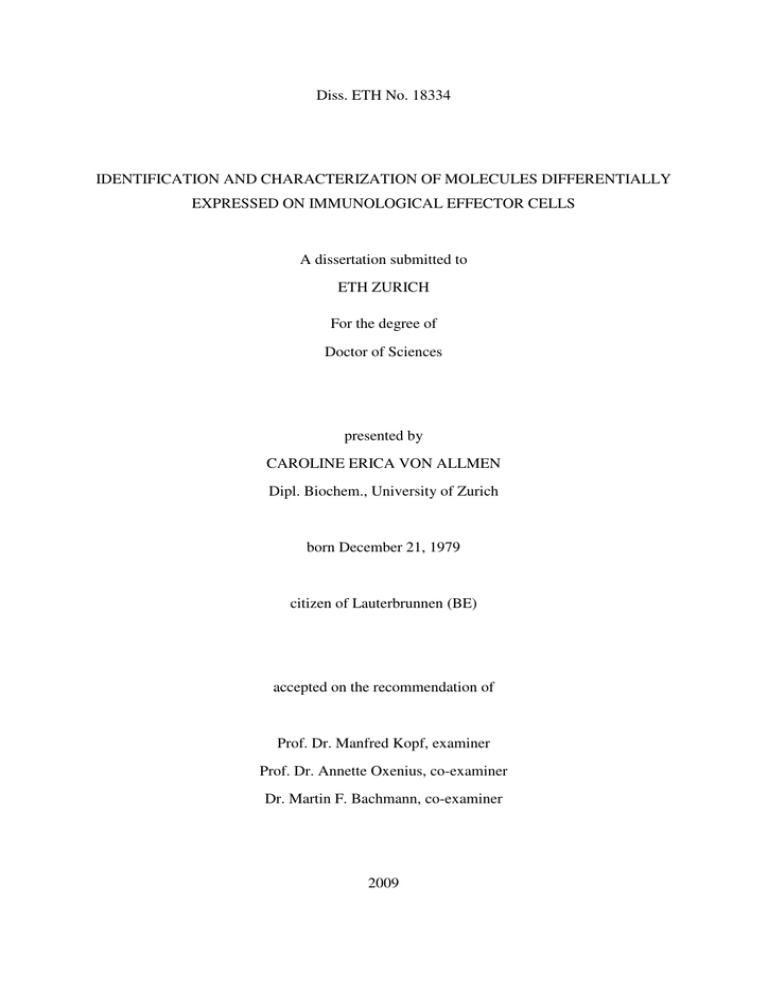
Diss. ETH No. 18334 IDENTIFICATION AND CHARACTERIZATION OF MOLECULES DIFFERENTIALLY EXPRESSED ON IMMUNOLOGICAL EFFECTOR CELLS A dissertation submitted to ETH ZURICH For the degree of Doctor of Sciences presented by CAROLINE ERICA VON ALLMEN Dipl. Biochem., University of Zurich born December 21, 1979 citizen of Lauterbrunnen (BE) accepted on the recommendation of Prof. Dr. Manfred Kopf, examiner Prof. Dr. Annette Oxenius, co-examiner Dr. Martin F. Bachmann, co-examiner 2009 SUMMARY 1. SUMMARY Adaptive immunity relies on the function of specialized cells to regulate an immune response. These immune cells have the difficult task to destroy pathogens while leaving the host essentially intact. While the immune system is usually up to this task, this may not always be the case. Plasma cells may illustrate this difficulty. They are critical for humoral immunity since they are the main producers of antibody. However, though plasma cells are therefore important mediators in protective immunity, they may also contribute to autoimmune diseases, such as lupus erythematosus (SLE), by producing autoantibodies. Regulatory T cells (Tregs) may serve as a second example, since the main role of this cell type is controlling and dampening immune effector responses. The present study aimed at identifying and characterising novel molecules selectively expressed by these two cell types. In a fist part, screening for genes differentially expressed by Tregs resulted in the identification of secreted phospholipase A2 (sPLA2)-IID. We found that sPLA2-IID is selectively produced by freshly isolated as well as by in vitro differentiated Foxp3+ Tregs and is a potent mediator of Treg function, since it strongly suppressed proliferation of CD4+ and CD8+ T cells in vitro and in vivo. The inhibitory effect of sPLA2IID was independent of its catalytic activity and attenuated signaling through the PI3K/Akt/mTOR pathway. Furthermore, sPLA2-IID promoted the differentiation of Tregs. Importantly, administration of a sPLA2-IID-Fc fusion protein inhibited disease development in two murine disease models. The second part of this study characterized a novel surface marker for plasma cells. Despite their importance, analytics of plasma cells still suffers from the limited availability of specific markers. Currently, plasma cell identification relies on the expression of a single marker, CD138/syndecan-1. However, syndecan-1 is widely expressed on various cell types outside the hematopoietic compartment and, furthermore, not expressed on all subsets of plasma cells. To discover novel surface markers, a differential screening followed by signal sequence trap cloning was developed, leading to the identification of mouse Ly-6K (mLy-6K). Expression profiling using quantitative PCR and specific antibodies confirmed that mLy-6K is expressed by plasma cells of the spleen, lymph node, bone marrow and lamina propria of the small intestine but not by naïve B cells or tissues not containing plasma cells. 2 SUMMARY Taken together, this thesis provides a novel plasma cell marker and novel mechanisms of Treg function that might be exploited therapeutically. 3 ZUSAMMENFASSUNG 2. ZUSAMMENFASSUNG Das adaptive Immunsystem kennzeichnet sich durch spezialisierte Zellen aus, welche Immunantworten regulieren, um Krankheitserreger abzutöten. Da diese Immunantwort folglich zerstört, ist es absolut notwendig, dass diese Immunreaktion nur gegen Pathogene gerichtet ist und der Organismus nicht beeinträchtigt wird. Gelegentlich versagt das Immunsystem jedoch trotzdem. Diese Problematik äussert sich in Plasmazellen. Sie sind für die humorale Immunität zuständig, da sie die grössten Mengen an Antikörpern produzieren. Obschon Plasmazellen den Körper schützen, können sie dennoch gegen eigene Zellen und Moleküle reagieren, was zu Autoimmunkrankheiten beitragen kann, wie zum Beispiel zu Lupus erythematosus, indem sie Autoantiköper ausschütten. Ein zweites Beispiel hierfür sind regulatorische T Zellen, deren Hauptfunktion die Kontrolle und das Mässigen von Immunreaktionen ist. Ziel der vorliegenden Studie war die Identifizierung und Charakterisierung von neuen Molekülen, welche von den obengenannten Zelltypen exprimiert werden. In einem ersten Teil selektierten wir für Gene, die differenziell von regulatorischen T Zellen exprimiert werden, und identifizierten so eine sekretierte Phospholipase vom Typ A2 (sPLA2)-IID. Wir bestätigten, dass sPLA2-IID selektiv von frisch isolierten und in vitro differenzierten Foxp3+ regulatorischen T Zellen exprimiert wird, und entdeckten, dass sPLA2-IID die Proliferation von CD4+ and CD8+ T Zellen in vitro und in vivo supprimierte. Dieser inhibitorische Effekt war unabhängig von der katalytischen Aktivität der Phospholipase und dämpfte den PI3K/Akt/mTOR Signalweg. Ferner begünstigte sPLA2-IID die Differenzierung von regulatorischen T Zellen. Die Administration von sPLA2-IID-Fc Fusionsproteinen reduzierte den Krankheitsverlauf in zwei verschiedenen Mausmodellen. Im zweiten Teil dieser Studie wird ein neuartiger Oberflächenmarker für Plasmazellen charakterisiert. Denn trotz der besonderen Bedeutung von Plasmazellen, sind nur wenige spezifische Marker für deren Analytik vonhanden. Zurzeit werden Plasmazellen mittels eines einzigen Markers detektiert (CD138/Syndecan-1). Allerdings wird Syndecan-1 auch auf anderen Zelltypen ausserhalb des hämatopoietischen Kompartementes verbreitet exprimiert und ausserdem auch nicht auf allen Subtypen von Plasmazellen. Um neue spezifische Oberflächenmarker zu entdecken, entwickelten wir eine Methode, ein “differenzielles Screening“ mit anschliessender “Signal Sequence Trap“. Mit deren Hilfe konnten wir das Mausprotein Ly-6K (mLy-6K) identifizieren. Wir erstellten ein Expressionsprofil mit 4 ZUSAMMENFASSUNG quantitativem PCR und spezifischen Antikörpern gegen mLy-6K, welches bestätigte, dass mLy-6K auf Plasmazellen von der Milz, den Lymphknoten, dem Knochenmark und der Lamina Propria des Dünndarms, aber nicht auf naiven B Zellen oder Geweben, welche keine Plasmazellen enthalten, exprimiert wird. In dieser Studie haben wir einen neuen Oberflächenmarker für Plasmazellen identifiziert und neue Erkenntisse über den Mechanismus von regulatorischen T Zellen gewonnen, welche therapeutisch angewendet werden könnten. 5
